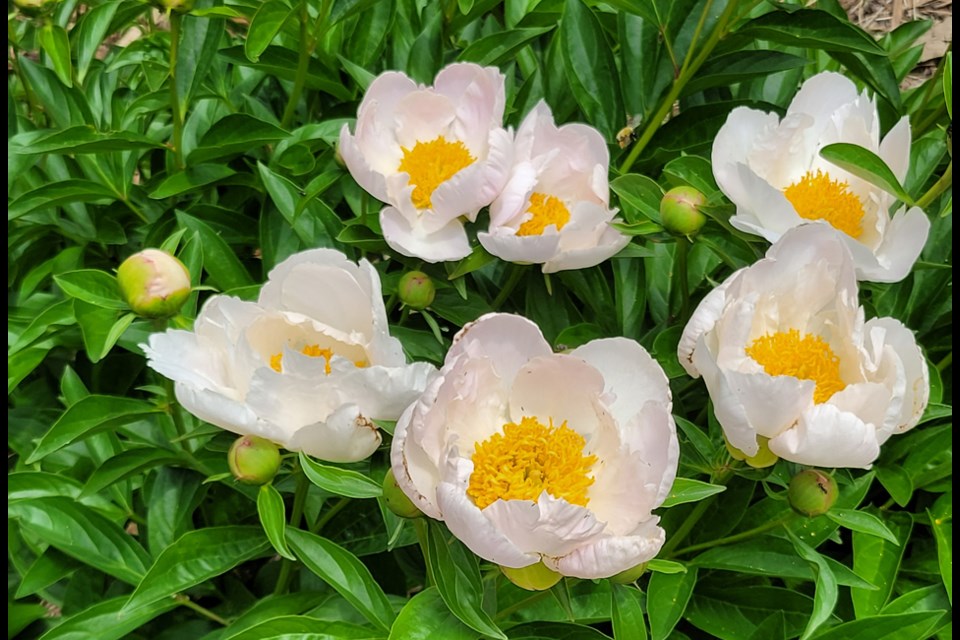Some time ago, a trip to England included the white garden in Sissinghurst. I have always been attracted to white flowering plants, so upon my return home, I decided to make a central flower bed featuring white flowers. You have to be careful what you wish for, because you might get it. Pretty soon, I had a flower bed of white, surrounded by a lawn that also included white Dutch clover. I had effectively created a winter landscape in the middle of summer. Needless to say, it was a bit overpowering, and I have been adding in some colour ever since. So, for those who want to start a white garden, I would suggest that you plan to incorporate some blues, pinks or greys right from the get-go.
Nevertheless, white can provide great accents and contrast in an otherwise coloured landscape. Here are some white plants that I love.
Early Spring
‘Spring Snow’ is a fruitless crabapple with fragrant flowers and dense foliage developed by Bert Porter of Honeywood Nurseries. It is drought-tolerant and extremely cold-hardy. It grows to 6m tall and wide. I was sold a crabapple as ‘Spring Snow’ but my specimen has small fruit. Since it is not near a walkway, this is not a problem, and it does provide me with great spring interest, whatever variety it is.
Viburnum opulus ‘Snowball Bush,’ is a beautiful shrub with 10cm round snowball-like flowers. Relatively short-lived, it was a great addition while in my landscape. About 150cm high, unfortunately, after about five years, it became confused with the seasons and began blooming a second time in late fall. This resulted in not being prepared for winter. It never leafed out the next spring.
Lebanon onion (Allium zebdanense) is a flowering onion that hails from the Middle East. Planted in the fall about five years ago, it is naturalizing in my front garden. It grows to about the same height as common chives with beautiful, delicate flowers in late May.
Allium stippitatum ‘White Giant’ is about 90cm tall and has 10+cm round globes of densely packed flowers. A great pollinator plant, it naturalizes easily and blooms in early June.
Late Spring
‘White Swan’ large-petaled clematis (Clematis macropetela), a vine hybridized by Frank Skinner from Dropmore, Manitoba, is featured at the Heritage Rose Garden at the Saskatoon Forestry Farm Park. Supported by an arbour about 150 cm in height, it starts blooming on old wood at the end of May.
Peonies come in colours from white to pink, red and even yellow. One of the very beautiful single bloom peonies is ‘Krinkled White’, blooming in the gardens in mid-June. The large blossoms of crinkled white with golden stamens in the centre are borne on flexible stems and do not require support. It is slightly fragrant, makes a great cut flower and the foliage remains attractive through the summer. Another white variety is ‘Frances Willard’, which has sturdy stems, but some years requires staking because of its very large double flower heads. ‘Festiva Maxima’ is a popular choice and has been in cultivation for over 150 years. The large white flowers (15+cm) with crimson accents are on 90cm sturdy stems, and need to be supported in my garden.
Next to flower are the roses. I have ‘Morden Snow Beauty,’ which always puts on a great show. Although it often suffers die-back in early spring, it never fails to recover and delight, with slightly fragrant flushes of white semi-double flowers. So far, it has remained disease-free. It is well established and I have had it for over twenty years. Roses benefit from careful pruning in spring, once they begin leafing out, as well as careful deadheading to encourage a second flush of blooms. ‘Oscar Peterson’ is a white rose, released in the Artist Series of Canadian roses, after the rose breeding was discontinued in Ottawa, along with ‘Henry Hudson’, a fragrant rugosa rose in the Explorer series of roses, which would be a great addition to a white garden.
A unique plant in my garden is the white gas plant (Dictamnus albus). It forms a bushy, upright mound with spiky, fragrant, pure white flowers. The seedpods, formed after flowering, continue to give the plant interest. It grows about 60 to 90cm tall. Wear gloves when handling the plant, as some people are sensitive to its touch. It has a lemony smell and produces volatile oils, which can be ignited on hot summer days. The burning bush referred to in the bible may well have been a gas plant.
Stay tuned next week, when we continue the white blooms into Summer.
This column is provided courtesy of the Saskatchewan Perennial Society.
(SPS; [email protected]). Check our website (www.saskperennial.ca) or Facebook page (www.facebook.com/saskperennial) for a list of upcoming gardening events.




